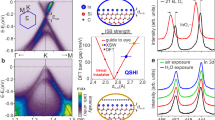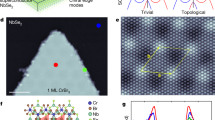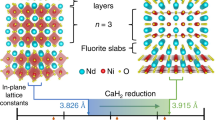Abstract
Two-dimensional (2D) topological materials, including quantum spin/anomalous Hall insulators, have attracted intense research efforts owing to their promise for applications ranging from low-power electronics and high-performance thermoelectrics to fault-tolerant quantum computation. One key challenge is to fabricate topological materials with a large energy gap for room-temperature use. Stanene—the tin counterpart of graphene—is a promising material candidate distinguished by its tunable topological states and sizeable bandgap. Recent experiments have successfully fabricated stanene, but none of them have yet observed topological states. Here we demonstrate the growth of high-quality stanene on Cu(111) by low-temperature molecular beam epitaxy. Importantly, we discovered an unusually ultraflat stanene showing an in-plane s–p band inversion together with a spin–orbit-coupling-induced topological gap (~0.3 eV) at the Γ point, which represents a foremost group-IV ultraflat graphene-like material displaying topological features in experiment. The finding of ultraflat stanene opens opportunities for exploring two-dimensional topological physics and device applications.
This is a preview of subscription content, access via your institution
Access options
Access Nature and 54 other Nature Portfolio journals
Get Nature+, our best-value online-access subscription
$29.99 / 30 days
cancel any time
Subscribe to this journal
Receive 12 print issues and online access
$259.00 per year
only $21.58 per issue
Buy this article
- Purchase on Springer Link
- Instant access to full article PDF
Prices may be subject to local taxes which are calculated during checkout




Similar content being viewed by others
Data availability
The data that support the findings of this study are available from the corresponding authors upon reasonable request.
References
Hasan, M. Z. & Kane, C. L. Colloquium: Topological insulators. Rev. Mod. Phys. 82, 3045–3067 (2010).
Qi, X. L. & Zhang, S. C. Topological insulators and superconductors. Rev. Mod. Phys. 83, 1057–1110 (2011).
Bernevig, B. A., Hughes, T. L. & Zhang, S. C. Quantum spin Hall effect and topological phase transition in HgTe quantum wells. Science 314, 1757–1761 (2006).
König, M. et al. Quantum spin Hall insulator state in HgTe quantum wells. Science 318, 766–770 (2007).
Liu, C., Hughes, T. L., Qi, X. L., Wang, K. & Zhang, S. C. Quantum spin Hall effect in inverted type-II semiconductors. Phys. Rev. Lett. 100, 236601 (2008).
Knez, I., Du, R. R. & Sullivan, G. Evidence for helical edge modes in inverted InAs/GaSb quantum wells. Phys. Rev. Lett. 107, 136603 (2011).
Chang, C. Z. et al. Experimental observation of the quantum anomalous Hall effect in a magnetic topological insulator. Science 340, 167–170 (2013).
Kane, C. L. & Mele, E. J. Quantum spin Hall effect in graphene. Phys. Rev. Lett. 95, 226801 (2005).
Liu, C. C., Feng, W. X. & Yao, Y. G. Quantum spin Hall effect in silicene and two-dimensional germanium. Phys. Rev. Lett. 107, 076802 (2011).
Xu, Y. et al. Large-gap quantum spin Hall insulators in tin films. Phys. Rev. Lett. 111, 136804 (2013).
Qian, X. F., Liu, J. W., Fu, L. & Li, J. Quantum spin Hall effect in two-dimensional transition metal dichalcogenides. Science 346, 1344–1347 (2014).
Molle, A. et al. Buckled two-dimensional Xene sheets. Nat. Mater. 16, 163–169 (2017).
Vogt, P. et al. Silicene: compelling experimental evidence for graphenelike two-dimensional silicon. Phys. Rev. Lett. 108, 155501 (2012).
Feng, B. J. et al. Evidence of silicene in honeycomb structures of silicon on Ag(111). Nano. Lett. 12, 3507–3511 (2012).
Dávila, M. E., Xian, L., Cahangirov, S., Rubio, A. & Le Lay, G. Germanene: a novel two-dimensional germanium allotrope akin to graphene and silicene. New J. Phys. 16, 095002 (2014).
Li, L. F. et al. Buckled germanene formation on Pt(111). Adv. Mater. 26, 4820–4824 (2014).
Zhu, F. F. et al. Epitaxial growth of two-dimensional stanene. Nat. Mater. 14, 1020–1025 (2015).
Liu, Z. et al. Stable nontrivial Z2 topology in ultrathin Bi (111) films: A first-principles study. Phys. Rev. Lett. 107, 136805 (2011).
Reis, F. et al. Bismuthene on a SiC substrate: A candidate for a high-temperature quantum spin Hall material. Science 357, 287–290 (2017).
Wu, S. F. et al. Observation of the quantum spin Hall effect up to 100 kelvin in a monolayer crystal. Science 359, 76–79 (2018).
Tang, S. J. et al. Quantum spin Hall state in monolayer 1T’-WTe2. Nat. Phys. 13, 683–687 (2017).
Fei, Z. Y. et al. Edge conduction in monolayer WTe2. Nat. Phys. 13, 677–682 (2017).
Xu, Y., Gan, Z. X. & Zhang, S. C. Enhanced thermoelectric performance and anomalous Seebeck effects in topological insulators. Phys. Rev. Lett. 112, 226801 (2014).
Wu, S. C., Shan, G. C. & Yan, B. H. Prediction of near-room-temperature quantum anomalous Hall effect on honeycomb materials. Phys. Rev. Lett. 113, 256401 (2014).
Wang, J., Xu, Y. & Zhang, S. C. Two-dimensional time-reversal-invariant topological superconductivity in a doped quantum spin-Hall insulator. Phys. Rev. B 90, 054503 (2014).
Gou, J. et al. Strain-induced band engineering in monolayer stanene on Sb(111). Phys. Rev. Mater. 1, 054004 (2017).
Zang, Y. Y. et al. Realizing an epitaxial decorated stanene with an insulating bandgap. Adv. Funct. Mater. 28, 1802723 (2018).
Song, Y. H. et al. High-buckled R3 stanene with topologically nontrivial energy gap. Preprint at https://arxiv.org/abs/1707.08657 (2017).
Xu, C.-Z. et al. Gapped electronic structure of epitaxial stanene on InSb(111). Phys. Rev. B 97, 035122 (2018).
Yuhara, J. et al. Large area planar stanene epitaxially grown on Ag(1 1 1). 2D Mater. 5, 025002 (2018).
Liao, M. H. et al. Superconductivity in few-layer stanene. Nat. Phys. 14, 344–348 (2018).
Zhou, M. et al. Epitaxial growth of large-gap quantum spin Hall insulator on semiconductor surface. Proc. Natl Acad. Sci. USA 111, 14378–14381 (2014).
Zhang, G. F., Li, Y. & Wu, C. J. Honeycomb lattice with multiorbital structure: Topological and quantum anomalous Hall insulators with large gaps. Phys. Rev. B 90, 075114 (2014).
Wu, C. J., Bergman, D., Balents, L. & Sarma, S. D. Flat bands and Wigner crystallization in the honeycomb optical lattice. Phys. Rev. Lett. 99, 070401 (2007).
Yan, B. H. et al. Topological states on the gold surface. Nat. Commun. 6, 10167 (2015).
Son, Y. W., Cohen, M. L. & Louie, S. G. Half-metallic graphene nanoribbons. Nature 444, 347–349 (2006).
Yazyev, O. V. & Helm, L. Defect-induced magnetism in graphene. Phys. Rev. B 75, 125408 (2007).
Lahiri, J., Lin, Y., Bozkurt, P., Oleynik, I. I. & Batzill, M. An extended defect in graphene as a metallic wire. Nat. Nanotech. 5, 326–329 (2010).
Huang, P. Y. et al. Grains and grain boundaries in single-layer graphene atomic patchwork quilts. Nature 469, 389–392 (2011).
Ma, C. X. et al. Evidence of van Hove singularities in ordered grain boundaries of graphene. Phys. Rev. Lett. 112, 226802 (2014).
Tao, L. et al. Silicene field-effect transistors operating at room temperature. Nat. Nanotech. 10, 227–231 (2015).
Kresse, G. & Furthmüller, J. Efficient iterative schemes for ab initio total-energy calculations using a plane-wave basis set. Phys. Rev. B 54, 11169 (1996).
Blöchl, P. E. Projector augmented-wave method. Phys. Rev. B 50, 17953 (1994).
Perdew, J. P., Burke, K. & Ernzerhof, M. Generalized gradient approximation made simple. Phys. Rev. Lett. 77, 3865–3868 (1996).
Mostofi, A. A. et al. wannier90: A tool for obtaining maximally-localised Wannier functions. Comput. Phys. Commun. 178, 685–699 (2008).
Wu, Q. S., Zhang, S. N., Song, H.-F., Troyer, M. & Soluyanov, A. A. Wannier Tools: An open-source software package for novel topological materials. Comput. Phys. Commun. 224, 4059–4416 (2018).
Acknowledgements
This work was supported by the National Key R&D Program of China (grants nos 2016YFA0200603, 2017YFA0205004, 2018YFA0305603, 2016YFA0301001, 2018YFA0307100), the ‘Strategic Priority Research Program’ of CAS (XDB01020100), the National Natural Science Foundation of China (grants nos 91321309, 51132007, 21421063, 21473174, 21273210, 51788104), and the Fundamental Research Funds for the Central Universities (WK2060190084, WK2340000065). A.Z. acknowledges a fellowship from the Youth Innovation Promotion Association of CAS (2011322). Y.X. acknowledges support from the Tsinghua University Initiative Scientific Research Program and the National Thousand-Young-Talents Program. The calculations were done on the ‘Explorer 100’ cluster system of Tsinghua University and on the ‘Tianhe-2’ of the National Supercomputer Computer Center in Guangzhou. W.D. acknowledge support from the National Natural Science Foundation of China (grants nos 11674188 and 11334006), and the Beijing Advanced Innovation Center for Future Chip (ICFC). S.-C.Z. is supported by the US Department of Energy, Office of Basic Energy Sciences, Division of Materials Sciences and Engineering under Contract No. DE-AC02-76SF00515.
Author information
Authors and Affiliations
Contributions
A.Z., Y.X., B.W., W.D., S.-C.Z. and J.G.H. devised the experiments and provided financial and other support for the experiments and calculations. J.D. H.S. and X.Z. performed the MBE growth and STM/STS measurements. B.X., H.C., B.L. and Y.X. performed theoretical calculations. X.M. and J.D. performed the ARPES measurements. A.Z., Y.X., B.W., W.D., S.-C.Z. and J.G.H. analysed the data. A.Z. and Y.X. wrote the paper with input from other co-authors.
Corresponding authors
Ethics declarations
Competing interests
The authors declare no competing interests.
Additional information
Publisher’s note: Springer Nature remains neutral with regard to jurisdictional claims in published maps and institutional affiliations.
Supplementary information
Supplementary Materials
Supplementary Figures 1–9, Extended Discussion of Computational Results, Supplementary References 1–4
Rights and permissions
About this article
Cite this article
Deng, J., Xia, B., Ma, X. et al. Epitaxial growth of ultraflat stanene with topological band inversion. Nature Mater 17, 1081–1086 (2018). https://doi.org/10.1038/s41563-018-0203-5
Received:
Accepted:
Published:
Issue Date:
DOI: https://doi.org/10.1038/s41563-018-0203-5
This article is cited by
-
Atomic-scale magnetic doping of monolayer stanene by revealing Kondo effect from self-assembled Fe spin entities
npj Quantum Materials (2024)
-
Repurposing Amphotericin B: anti-microbial, molecular docking and molecular dynamics simulation studies suggest inhibition potential of Amphotericin B against MRSA
BMC Chemistry (2023)
-
Stanene: State of the Art and Future Prospects
Journal of Electronic Materials (2023)
-
Two-dimensional superconductors with intrinsic p-wave pairing or nontrivial band topology
Science China Physics, Mechanics & Astronomy (2023)
-
A review of low-cost approaches to synthesize graphene and its functional composites
Journal of Materials Science (2023)



